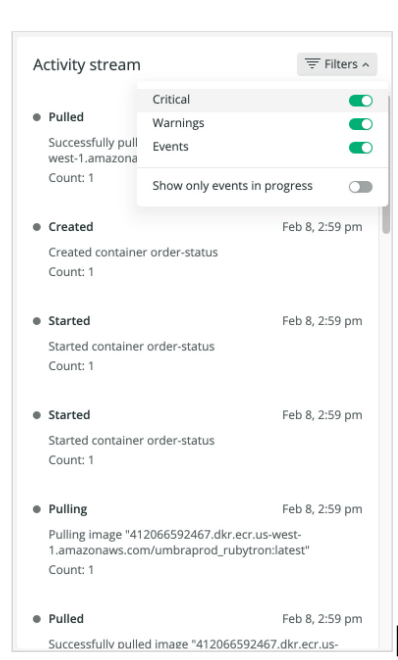We’ve updated our Kubernetes experience to add support for multi-cluster Kubernetes workloads. You can connect Kubernetes application and cluster performance data in a single user interface in New Relic application performance monitoring (APM). By doing so, you can identify and resolve problems within Kubernetes clusters and their associated workloads, helping you debug faster and scale infrastructure resources as required.
Analyze performance in a single experience
Our Kubernetes experience curates application and cluster performance data in a new UI, helping you build more performant applications. The new experience provides these capabilities directly within the APM experience:
- A single, curated UI that combines APM and Kubernetes cluster performance data, eliminating the need to navigate between APM and infrastructure monitoring in New Relic to manually correlate data.
- A real-time activity stream that alerts you to Kubernetes events and critical issues.
- One-click logs and side-by-side, selectable metrics to correlate and investigate performance anomalies.
Why developers need to understand cluster performance
Kubernetes has blurred the lines between application and infrastructure. If you’re a developer, your primary focus is on the application and not the cluster's performance but the cluster's underlying components can have a direct impact on how well your application performs.
Most monitoring tools silo application data from infrastructure signals. That doesn’t work in Kubernetes environments. Our new experience integrates these areas so you can easily understand how Kubernetes infrastructure affects your apps. These UI changes make it easier to view the entire landscape of your telemetry data and work together across teams.
Correlate performance between apps and clusters
Whether you’re troubleshooting or optimizing performance, the ability to identify all the underlying components and see how they’re performing is critical, especially if you’re deploying workloads with multiple clusters. With our new Kubernetes experience in application performance monitoring, you can understand how cluster performance impacts your applications. Because we link the metadata of all of your entities, you’ll see the workloads, deployments, daemonsets, pods, and hosts that your clusters are linked to.
For example, when latency exceeds acceptable limits, you might find that memory utilization is too high and pods are being killed because they are out of memory (OOMKilled) due to insufficient cluster resources. With our new UI changes, you’ll see this behavior in the pods and containers summary as well as in the activity stream.
The activity stream helps you understand the relationship between your cluster’s performance and cluster events. As apps are deployed, these important events help you understand how they interrelate to cluster performance, and ultimately, application performance. Additionally, we provide the opportunity for you to filter events so that when problems arise, you can focus on what matters most.

Investigate anomalies faster
Investigating anomalies can be difficult, which is compounded when relevant data is scattered among different UIs, or worse, among different tools. That’s why we’ve prioritized giving you access to all the information you need in one place. In addition to performance metrics that you’d expect, such as CPU, memory, network, and storage, you have access to relevant logs so you can see what’s driving performance changes. We added metadata that links your logs with your related Kubernetes telemetry data, such as errors or cluster performance data, so you can home in on exactly the right data to understand what's affecting your application’s performance.
And when you want to correlate performance across metrics, use the charts at the bottom of the page. To analyze how they're correlated, simply choose between any two metrics in each chart’s dropdown, including average, max, and p95. Because these charts are built using NRQL, you can open up these pre-built queries in a separate query builder to go beyond these charts and ask questions about your data.
You can select from these metrics:
- CPU usage (cores)
- CPU utilization (%)
- CPU throttling (%)
- Memory usage (bytes)
- Memory utilization (%)
- Network received (KBps)
- Network transmitted (KBps)
- Network errors (per second)
- Storage usage (bytes)
- Storage utilization (%)
- Container restart count
Get started today
Our new Kubernetes experience is now available to all full platform users. Get started today by navigating to APM, and on the left-side navigation, select Kubernetes. To learn more, read our Kubernetes docs.
If you don't have a New Relic account yet, get started for free. Your free account includes 100 GB/month of free data ingest, one free full-access user, and unlimited free basic users.
The views expressed on this blog are those of the author and do not necessarily reflect the views of New Relic. Any solutions offered by the author are environment-specific and not part of the commercial solutions or support offered by New Relic. Please join us exclusively at the Explorers Hub (discuss.newrelic.com) for questions and support related to this blog post. This blog may contain links to content on third-party sites. By providing such links, New Relic does not adopt, guarantee, approve or endorse the information, views or products available on such sites.
This blog post contains “forward-looking” statements, as that term is defined under the federal securities laws, including but not limited to statements regarding expected features and benefits of New Relic’s Kubernetes experience, including any anticipated benefits, results, and future opportunities related thereto. The achievement or success of the matters covered by such forward-looking statements are based on New Relic’s current assumptions, expectations, and beliefs and are subject to substantial risks, uncertainties, assumptions, and changes in circumstances that may cause New Relic’s actual results, performance, or achievements to differ materially from those expressed or implied in any forward-looking statement. Further information on factors that could affect New Relic’s financial and other results and the forward-looking statements in this post is included in the filings New Relic makes with the SEC from time to time, including in New Relic’s most recent Form 10-Q, particularly under the captions “Risk Factors” and “Management’s Discussion and Analysis of Financial Condition and Results of Operations.” Copies of these documents may be obtained by visiting New Relic’s Investor Relations website at http://ir.newrelic.com or the SEC’s website at www.sec.gov. New Relic assumes no obligation and does not intend to update these forward-looking statements, except as required by law.



